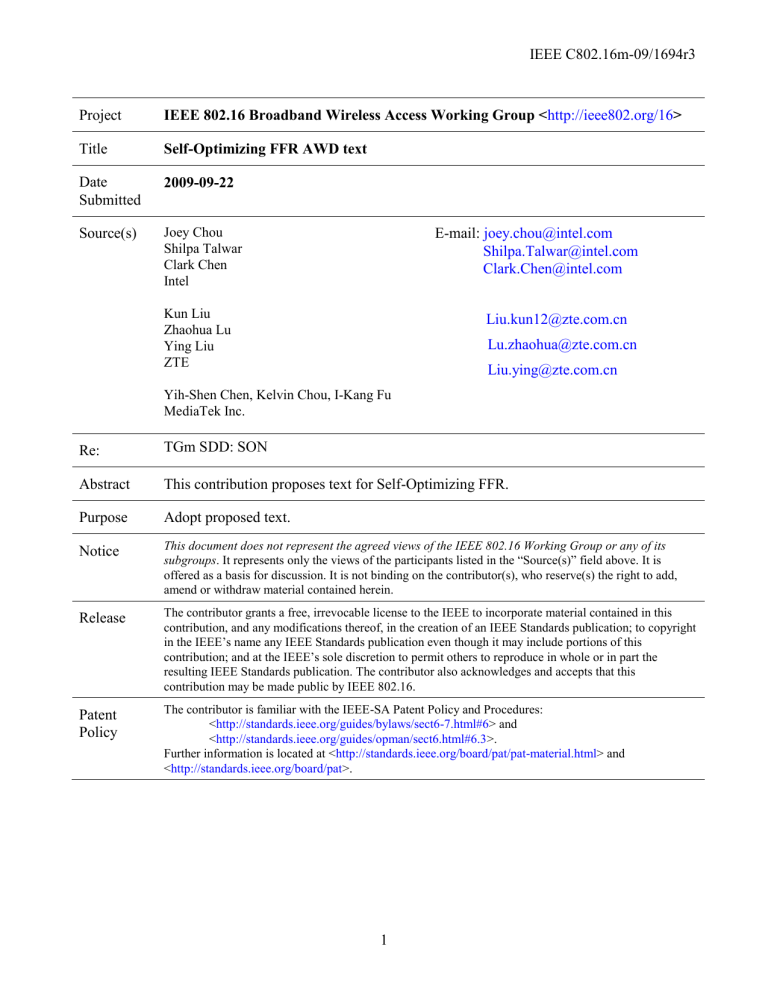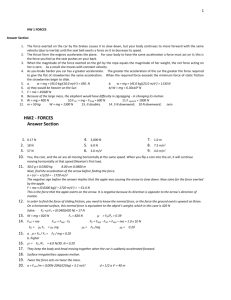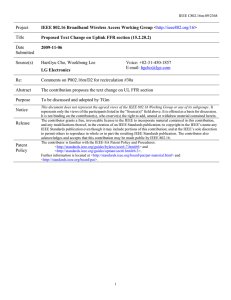IEEE C802.16m-09/1694r3 Project Title

IEEE C802.16m-09/1694r3
Project
Title
Date
Submitted
IEEE 802.16 Broadband Wireless Access Working Group < http://ieee802.org/16 >
Self-Optimizing FFR AWD text
2009-09-22
Source(s) Joey Chou
Shilpa Talwar
Clark Chen
Intel
Kun Liu
Zhaohua Lu
Ying Liu
ZTE
Yih-Shen Chen, Kelvin Chou, I-Kang Fu
MediaTek Inc.
Re:
TGm SDD: SON
Abstract
Purpose
E-mail: joey.chou@intel.com
This contribution proposes text for Self-Optimizing FFR
.
Shilpa.Talwar@intel.com
Clark.Chen@intel.com
Liu.kun12@zte.com.cn
Liu.ying@zte.com.cn
Lu.zhaohua@zte.com.cn
Notice
Release
Patent
Policy
Adopt proposed text.
This document does not represent the agreed views of the IEEE 802.16 Working Group or any of its subgroups . It represents only the views of the participants listed in the “Source(s)” field above. It is offered as a basis for discussion. It is not binding on the contributor(s), who reserve(s) the right to add, amend or withdraw material contained herein.
The contributor grants a free, irrevocable license to the IEEE to incorporate material contained in this contribution, and any modifications thereof, in the creation of an IEEE Standards publication; to copyright in the IEEE’s name any IEEE Standards publication even though it may include portions of this contribution; and at the IEEE’s sole discretion to permit others to reproduce in whole or in part the resulting IEEE Standards publication. The contributor also acknowledges and accepts that this contribution may be made public by IEEE 802.16.
The contributor is familiar with the IEEE-SA Patent Policy and Procedures:
< http://standards.ieee.org/guides/bylaws/sect6-7.html#6 > and
< http://standards.ieee.org/guides/opman/sect6.html#6.3
>.
Further information is located at < http://standards.ieee.org/board/pat/pat-material.html
> and
< http://standards.ieee.org/board/pat >.
1
IEEE C802.16m-09/1694r3
Self-Optimizing FFR
Joey Chou, Shilpa Talwar, Clark Chen
Intel
Kun Liu, Zhaohua Lu, Ying Liu
ZTE
Yih-Shen Chen, Kelvin Chou, I-Kang Fu
MediaTek Inc.
I.
Introduction
This contribution proposes a self-optimizing FFR text for AWD.
II.
Proposed text
15.5 Support for Self-organization
Self Organizing Network (SON) functions are intended for BSs (e.g. Macro, Relay, Femtocell) to automate the configuration of BS parameters and to optimize network performance, coverage and capacity. The scope of
SON is limited to the measurement and reporting of air interface performance metrics from MS/BS, and the subsequent adjustments of BS parameters.
15.5.1 Self-Optimization
Increasing complexity and dynamic environment in today’s mobile networks require constant analysis, provisioning and tuning of huge amount of parameters for equipment spread across great geographical area to achieve optimal network performance. Self-optimization is the process of analyzing the measurements reported by BS/MS and fine-tuning the BS parameters in order to optimize the network performance in terms of QoS, network efficiency, throughput, cell coverage and cell capacity.
15.5.1.1 Self-optimizing FFR
Self-optimizing FFR is designed to automatically adjust FFR parameters (e.g. frequency partition sizes and power levels), among ABS sectors in order to optimize cell coverage / capacity and user experience.
Additional information of Self-optimizing FFR can be found in Annex B.1
Each ABS should report BSID, MS Number in the BS, MS location distribution, and MS UL/DL SINR distributions, UL / DL traffic distribution, Converged resource metrics (i.e. Resource metric of each FFR partition is the measure of the overall system resource usage by the partition – e.g. effective bandwidth due to reuse, transmission power, multi-antennas, and interference to other cells, …), UL IoT control parameter
IoT per FFR partition (as defined in <<<15.3.14.2>>>), in order to initiate self-optimizing FFR function.
At each FFR Partition Update Interval, FFR partitions size, Power Levels, Relative Load indicator –Reference
2
IEEE C802.16m-09/1694r3 resource metric, and Reference UL IoT control parameter
IoT
of each partition in a BS should be updated.
Table 1 lists the parameters are required to support self-optimizing FFR measurements.
System Name Time Reference Minimum
Value
Default
Value
ABS
ABS
ABS
FFR Partition Update
Interval
Traffic Data Sample
Interval
FFR Processing Timer
Time between FFR partition updates
Time between traffic data sample to be used to calculate traffic load distribution
The time given to the SON server to process FFR attributes and return the FFR tuning command
1 minute
1 second
1 second
30 minutes
10 seconds
Maximu m Value
1440 minutes
60 seconds
2 seconds 10 seconds
Table 1 —Parameters and constants
Annex B Support for Self-organization Networks (Informative)
B.1 Self-Optimizing FFR Procedures
FFR is intended to use frequency reuse factor = 1 to serve AMSs located in inner cell that do not experience significant inter-cell interference, and frequency reuse factor < 1 for AMSs located at the cell edge that tend to receive unacceptable level of interference.
Figure 1 shows the distribution of frequency partitions in a 3 sector cellular networks. F
1 / 3 , a
/ / F
1 / 3 , b
/ / F
1 / 3 , c a n d F
1 , d r r e p r r e s s e n t t t h e f f r r e q u e n c y p a r r t t i i t i i o n s for frequency reuse 1/3 and 1 respectively. A key requirement of self-optimizing FFR is to avoid collisions among neighboring sectors, when distributing frequency partitions and power levels to each ABS in the serving area.
3
IEEE C802.16m-09/1694r3
F
1 / 3 , c
F
1 / 3 , c
F
1 / 3 , a
FR ijk
F
1 , d
F
1 , d
F
1 , d
F
1 / 3 , c
F
1 / 3 , a
F
1 , d
F
F
1 , d
1 , d
F
1 / 3 , b
F
1 / 3 , a
F
1 / 3 , c
F
1 , d
F
1 , d
F
1 , d
F
1 / 3 , b
F
1 / 3 , a
F
1 / 3 , c
F
1 , d
F
1 , d
F
1 , d
F
1 / 3 , b
F
1 / 3 , c
F
1 / 3 , a
F
1 , d
F
1 , d
F
1 , d
F
1 / 3 , b
F
1 / 3 , a
FR ijk
F
1 , d
F
1 , d
F
1 , d
F
1 / 3 , b
F
1 / 3 , a
F
1 / 3 , c
F
1 , d
F
1 , d
F
1 , d
F
1 / 3 , b
F
1 / 3 , b
Figure 1: FFR Frequency Partition Distributions
Since FFR is mainly designed for the benefit of cell edge users, an obvious parameter will be the AMS location distribution. However, some AMSs, even though not located in the cell edge, may receive poor SINR due to fading or shadowing. Therefore, SINR distribution parameters should be considered.
UL FFR is mainly depended on the UL IoT control parameter
IoT per FFR partition; the selection of
IoT per
FFR partition for each ABS can influence the UL FFR performance from the whole network view. Therefore,
IoT per FFR partition for each ABS should be considered.
In mobile WiMAX, the number of AMS and the traffic load carried in an ABS will fluctuate up and down continuously, as AMSs roam from ABS to ABS. In traditional frequency planning, the bandwidth allocated to each ABS is fixed that result in either traffic overload in some ABSs or bandwidth waste in other ABSs. FFR can support load balancing by taking into account the sector traffic loads of each sector in the FFR frequency partitions selection process.
Figure 2 shows an example of traffic load metrics that can be measured by counting the aggregate user data passing through at each Traffic Data Sample Interval. The smaller the sampling interval, the better resolution the traffic load data provides at the cost of higher overhead to the ABS. The traffic load samples count the number of octets of MAC PDUs (i.e. user data in MAC SDU, MAC headers, and MAC management messages) transmitted or received at the BS in a sampling interval. UL / DL traffic distribution can be use to validate the performance of self-optimizing FFR algorithm.
4
IEEE C802.16m-09/1694r3
Data Rate in Mbps
30
20
10
0
0 1 2 3 4 5 6 7 8 9 10 11 12 13 14 15 16
Time in
Seconds
Traffic Data Sampling Interval
Figure 2: Example of Traffic Load Metrics
Figure 3 shows the procedure of self-optimizing FFR.
AMS_1 AMS_N
A.1. AAI_FFR-CMD(Full Freq Partitions)
B.1. AAI_FFR-REP(Full Freq Partitions)
ABS
C.1. AAI_RNG-REQ( )
D.1. AAI_RNG-RSP(Timing adjustment)
.
..
A.1. AAI_FFR-CMD(Full Freq Partitions)
B.1. AAI_FFR-REP(Full Freq Partitions)
C.1. AAI_RNG-REQ( )
D.1. AAI_RNG-RSP(Timing adjustment)
E.. Sample traffic load
F.. Sample traffic load
G. Collect FFR measurement
Traffic
Data
Sample
Interval
SON Server
H. Report FFR measurement data)
I. Set FFR Processing Timer
J. Self-Optimizing algorithm at the SON server to Generate
FFR parameters
K. Receive a command to tune FFR parameters
L. Reset FFR Processing Timer
Figure 3: Procedure of Self-optimizing FFR
5
IEEE C802.16m-09/1694r3
Within each FFR Partition Update Interval, an ABS will send a AAI_FFR-CMD message to each AMS to measure RSSI and SINR in each partition. An ABS will use periodic ranging to measure the timing adjustment data that will be used to calculate the AMS location distribution.
6




